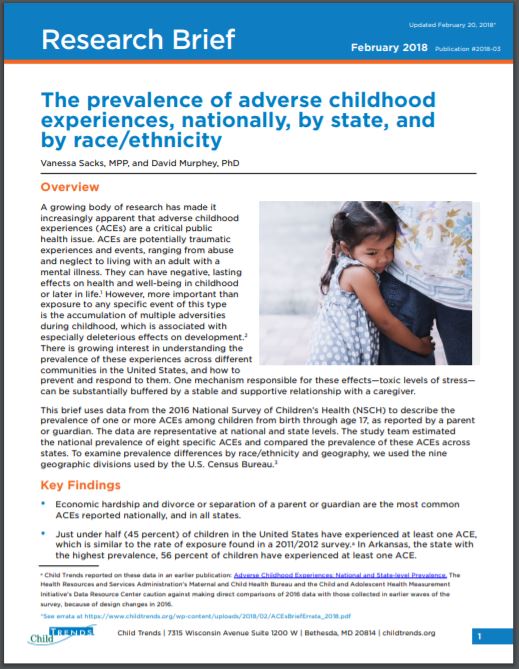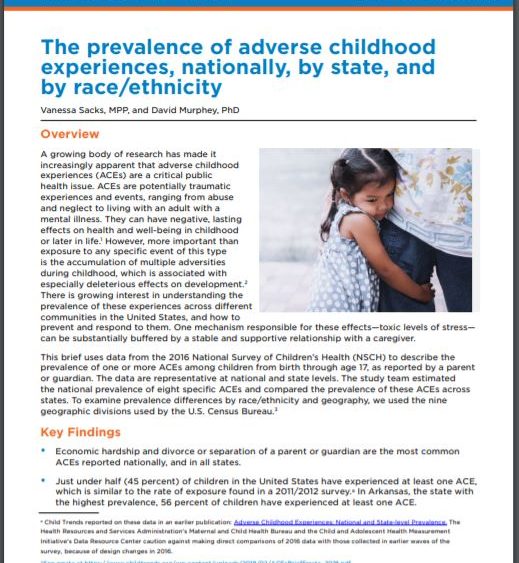 |
Close to half of children (45 percent) in the U.S. have experienced at least one adverse childhood experience (ACE)—an experience that could have negative and lasting effects on one’s health and wellbeing, such as depression, drug abuse, and poor physical health. One in 9 children has experienced three or more ACEs, placing them in a higher risk category for negative health outcomes both mental and physical. And African American and Hispanic children are more likely to have experienced ACES than white and Asian children. These are a few of the sobering key findings from a recent research brief by Child Trends, “The prevalence of adverse childhood experiences, nationally, by state, and by race/ethnicity,” examining the incidence of adverse childhood experiences in the U.S.
Based on data from the 2016 National Survey of Children’s Health, Child Trends reported on eight ACEs measures, which range from if a child has ever experienced economic hardships somewhat or very often to if a child has ever lived with anyone who was mentally ill or suicidal or severely depressed for more than a couple of weeks. Nationally, the two most common ACEs are experiencing economic hardships and having a parent or guardian separate or divorce, with approximately 1 in 4 children experiencing at least one of these.
The brief highlights racial and ethnic disparities that exist when looking at ACEs, specifically that African American and Hispanic children have the highest incidence of ACEs compared to their peers. For instance, African American children are two times as likely to have at least one ACE compared to white children (44 percent compared to 22 percent) and four times as likely as Asian children (11 percent). Hispanic children are close to two times as likely as white children to have two or more ACES (30 percent compared to 16 percent) and three times as likely as Asian children (10 percent). Conversely, Asian (77 percent) and white children (60 percent) are the most likely to never have had an adverse childhood experience, compared to 49 percent of Hispanic children and 39 percent of African American children.
At the state level, Arizona, Arkansas, Montana, New Mexico, and Ohio were states where the ratio of children who were in the higher category of risk, experiencing three or more ACEs, was as high as nearly 1 in 5 children. Maryland, Massachusetts, and Minnesota were states where the percentage of children who did not experience ACEs was lower than the national average, where 61 percent of Maryland children, 62 percent of Massachusetts children, and 63 percent of Minnesota children reported to have zero ACEs.
Despite the troubling findings related to the prevalence of ACEs, the brief does end on a positive and encouraging note. In addition to mentioning policy work being done at the state level to address ACEs, including establishing task forces to study ACEs and dedicating funding to ACEs prevention, authors call attention to the existence of protective factors—factors that prevent or minimize the impact of ACEs, such as positive, supportive relationships with adults and building children’s social and emotional skills. Afterschool and summer learning programs promote such protective factors and can be especially beneficial to communities who are most at-risk. With more than 10 million children in an afterschool program, including approximately 3.8 million Hispanic children and 2.4 million African American children, programs can have a significant positive impact on the students they serve. For instance, a recent McDowell Group report for the Alaska Afterschool Network, “Protective Factors for Youth Substance Abuse and Delinquency: The Role of Afterschool Programs,” describes the protective factors that afterschool programs can cultivate, from providing a positive connection to adults to helping students develop life skills and healthy social skills.
Given that the unmet demand for afterschool programs is incredibly high among African American and Hispanic children, where approximately 10 million children not currently in a program would be enrolled if one were available to them, the need for increased funding for more afterschool and summer learning opportunities is evident. Afterschool and summer learning programs are a part of a concerted effort to address ACEs, making support for both necessary to help ameliorate the effects of ACEs and build up our students’ and communities’ resilience.

Comments are closed.